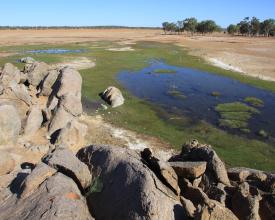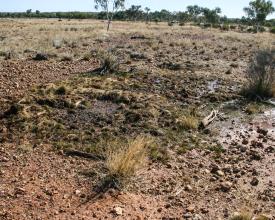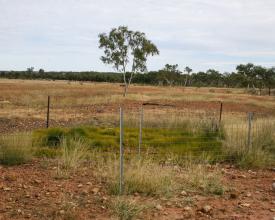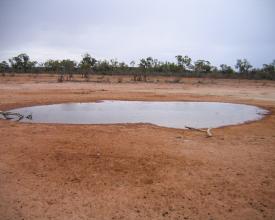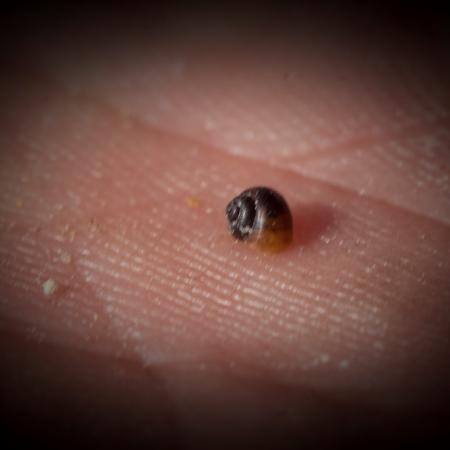
Artesian springs protection project
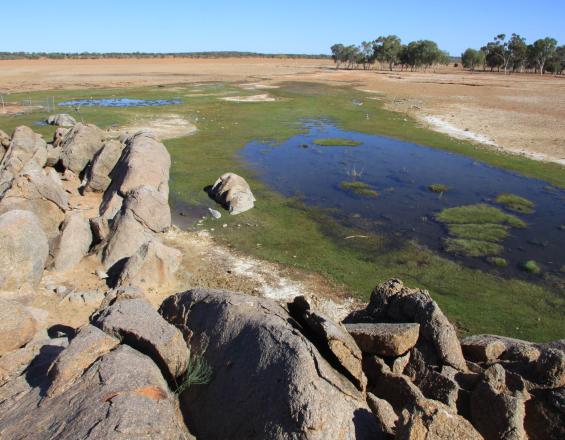
Wetland communities and artesian springs are a unique feature of semi-arid and arid Australia and have a high level of endemic flora and fauna. They are significant to the First Nation’s people, holding considerable value to the Budjiti people. The springs and wetland communities have significantly declined in condition due to over utilisation of the Great Artesian Basin, excavation for man-made dams, exotic plants, and cattle and feral animal disturbance. The Queensland Parks and Wildlife Service and Partnerships (QPWS&P) has implemented a successful domestic and feral animal control program to protect and enhance spring wetland communities with high conservation value. Targeted management actions addressed high levels of impacts of grazing, ground disturbance and reduced water quality and consumption. The approach was adopted to significantly improve the condition of the artesian springs through fencing, pest management program (mustering, culling, baiting) and monitoring program.
Contexto
Défis à relever
Standard landscape pest control programs fail to provide adequate protection of artesian spring wetland communities, especially in an extensive landscape such as western Queensland. This vast and remote country with variable weather presents many accessibility issues. Another challenge is the limited budget and resources to achieve sustainable outcomes.
Ubicación
Procesar
Summary of the process
Pest management can be a costly and resource intensive activity, especially in a vast landscape such as Australia. Artesian spring wetland recovery on Currawinya National Park was achieved through the application of a pest control program using a combination of a landscape based pest management and a targeted fencing program. Although the landscape programs were effective at reducing pest ungulate numbers, sufficient numbers remained in the landscape to threaten the spring wetlands. Fencing the individual spring groups was a cost efficient option used to address this ongoing threat. Monitoring results were used to evaluate management effectiveness of the program to ensure that desired outcomes were being achieved. Spring condition assessments showed that outcomes were being met, but also assessed the efficacy of different fencing techniques to ensure future fencing activities achieve the desired outcomes and inform other spring management projects.
Building Blocks
Pest management program
Feral goats, pigs, horses and cattle have been identified as a key threat to the spring wetland biodiversity and the overall biodiversity of the national park. The program aims to reduce the impacts of domestic and introduced ungulates to improve the condition of artesian spring ecosystems. The pest control program involves baiting (poison), mustering and culling to remove pests from the landscape.
Enabling factors
- Appropriate objectives and work towards park management goals.
- Adequate resources to implement the pest management program.
- Knowledge and understanding of pest ecology.
- Skills to undertake tasks, e.g. firearms and handling of poisons.
Lesson learned
- Threats need to be clearly defined.
- Threat management actions need to be based on science.
- Threat management actions need to be adaptive to respond to changing environmental conditions.
Pest exclusion fencing program
While landscape based pest management programs reduce pest animals numbers, they often leave sufficient animals in the landscape to cause significant and ongoing adverse impacts. Targeted high conservation value spring wetlands have been fenced to exclude pest animals while allowing native species access to the wetlands. Two types of fencing techniques were trialled, one larger area which enclosed the spring and wetland area, and one smaller area that allowed the ‘tail end’ of the spring to flow outside the spring and wetland area
.
Enabling factors
- Appropriate objectives that work towards park management goals.
- Resources (time and funding) for the installation and maintenance of fences.
- Knowledge and understanding of pest ecology.
Lesson learned
- Fencing is a cost effective spring wetland management tool.
- When used in combination with landscape pest control programs, fencing can achieve substantial and sustainable conservation outcomes.
Monitoring program for effectiveness and program outcomes
Monitoring is an essential component of any adaptive management program. To understand whether the artesian spring management program was successful, a suite of monitoring and assessment was undertaken. This involved photographic monitoring and condition assessments of the springs based on the amount of grazing, ground disturbance and visual water condition. Biological assessment of species diversity of plants and endemic gastropods were carried out.
Enabling factors
- Develops land management outcomes and knowledge.
- Evaluates management effectiveness.
- Documents program outcomes.
- Resources (time and staff) to undertaken monitoring.
- Skills to undertake monitoring and assessment.
Lesson learned
- Effective monitoring programs create better and more sustainable engagement by program stakeholders, reduces costs and allows for more effective use of project resources.
- Monitoring needs to be adaptive to ensure the desired outcomes are being measured.
- Results need to be easy to understand and readily available so that all stakeholders can appreciate how the program is achieving the desired program outcomes.
Impacts
The artesian spring protection project has resulted in a significant improvement of the condition of nationally listed ecological communities and conservation of species through management and removal of pests through a combined pest control program. Protecting the springs has resulted in an improvement in water quality, wetland extent and an increase in species abundance. This has also contributed to the protection of significant Budjiti people’s cultural values and cultural landscape.
Beneficiaries
The pest management program contributes economic benefit to both the community and Budjiti People through mustering employment. In addition, payments from mustering are also paid directly to the Budjiti People.
Sustainable Development Goals
Story

Artesian spring wetlands are known for their high biological, European cultural and First Nation people’s values. The Eulo supergroup consists of 111 individual spring groups, which includes ten biological important spring groups that contain a unique combination of endemic, Great Artesian Basin endemic and/or disjunct populations. These springs are subjected to a number of threatening processes, which includes impacts from domestic and feral ungulates.
The Tunga Springs is one of five biologically important springs on Currawinya National Park. This small spring group is in a remote section of the park and provides habitat for the molluscs: Jardinella cf eulo (AMS C. 156780) and plants: Myriophyllum artesium, Utricularia fenshamii, Schoenus falcatus, Triglochin nana and Utricularia dichotoma. There is limited surface water in the Tunga area, and hence the spring has suffered significant pest animal impacts. Pest animals are known to have an adversely impacted spring wetland species diversity and abundance. Some species may have even been lost before they were known to science.
A unique feature of artesian spring wetlands communities is the large number of endemic molluscs. Tunga Springs supports one endemic snail, which disappeared not long after its initial collection. The snail had not seen for over sixteen years most likely the result of high feral impact activity, which reduced the preferred habitat of the snail of clear shallow vegetated spring margins to extensive areas of vegetation less muddy quagmire. In 2012, Tunga Springs was acquired as part of Currawinya National Park and was fenced to exclude all feral animals in 2013. By 2014, the springs wetlands had fully recovered, and in 2016 a small number of snails were discovered on the largest of the springs, and in 2017 the snail is now considered as abundant. This program has not only benefitted the snail, but several other endemic plants have recovered, and there has been a significant increase in non-spring specialist species including birds, reptiles and frogs using these wetlands.
